LONDON, June 4th, 2025 – LettsGroup (www.Letts.Group) announces the public launch of its VentureFactory, a groundbreaking AI-native venture building platform, that has demonstrated the ability to reduce startup costs by up to 90% while significantly accelerating time-to-market and time-to-scaling. After more than two years of development and private beta testing and with several startups now successfully scaling, the platform will be available to any tech or digital startup from 5th June.
The AI VentureFactory represents the third generation of LettsGroup's proven Innov@te™ venture building system, which has powered the growth of tech unicorns and led to a number of successful exits. The platform combines AI-powered apps, tools and templates, expert guidance, and a structured process designed to help founders navigate the complex startup journey efficiently.

"Tech entrepreneurs face hundreds of critical decision points that can make or break their ventures," said Philip Letts, CEO of LettsGroup. "Our AI VentureFactory provides the process, structure, tools, and insights to optimise each step of the journey. We've eliminated the critical knowledge gaps that derail so many promising startups."
The platform's private beta has demonstrated impressive results across a number of tech and digital ventures, including an AI software startup helping manage, distribute and sell art better with 1,000 art galleries using its platform and a nature-tech startup with nearly 700 subscribers that launched just a few months ago. All of the early ventures have reached the Seed stage with sophisticated hi-tech products and some are already generating revenue.
LettsGroup's AI VentureFactory is supported by a team of Co-Pilot experts specialising in strategy, technology, product design, marketing, business development, and fundraising. The senior team has collectively helped build and lead dozens of groundbreaking tech companies worth over $50 billion in aggregate. The platform's AI, its agents and tools automate planning, strategy, research, pricing, forecasting, fundraising and much more. Its AI-powered apps include work tools and collaboration, planning tools, CRM, content marketing and AI note-taking,
The platform's track record of success leverages earlier versions of the Innov@te system to become the first fully fledged venture building agent. Innov@te in its earlier versions helped create one of the UK's first international internet unicorns (raising $80M before acquisition) and one of the first mobile software companies developing smartphone app stores (sold to Fujitsu for approximately $100M).
LettsGroup is excited to open its doors to tech and digital startups with its groundbreaking AI-native venture building platform that builds, scales and optimises companies at every stage. For accelerator companies, pre-Seed startups and venture capital portfolio companies looking for a system-driven, accelerated approach to venture building, the AI VentureFactory is a compelling choice.
Founders interested in leveraging the AI VentureFactory to power their startup journey should visit www.Letts.Group to sign up and gain access from June 5th.
Media Contact:
Peter Prince
+44 7545 967834
[email protected]
www.Letts.Group
LettsGroup's AI VentureFactory launches on June 5th for external ventures - view announcement here. This AI-native platform slashes startup building costs by up to 90% through Seed stage while dramatically accelerating time-to-market and boosting operational efficiency. Founders spend less time on operational overhead and more time building products customers actually want.The platform delivers the same venture building advantages that powered our branded ventures - now available to independent founders and investors. With integrated AI agents, tools, and applications purpose-built for tech startups, LG's AI VentureFactory transforms how digital ventures scale from concept to market to exit.
Ready to build better, faster and cheaper? Sign up here - whether you're a founder or investor looking for your next competitive edge.

LettsCore is readying for market launch in Q3 with its first enterprise customer fully rolled out. This month delivered critical technical milestones that position us to capture the emerging blockchain content management market:
Core Infrastructure Complete: We've implemented off-chain content storage with enhanced transaction histories that layer LettsCore-specific data onto Solana's blockchain records, creating unprecedented transparency and audit capabilities.
Revenue Systems Live: Our subscription and micropayment infrastructure has passed comprehensive edge-case testing, enabling multiple monetisation pathways from day one.
AI-Powered Product Suite: We've packaged three market-ready solutions: AI Search, automated social media content generation and distribution, and MCP extensions that integrate seamlessly with existing enterprise workflows.
Enterprise-Ready Foundation: Our proprietary AI toolkit now auto-generates testing frameworks and maintains comprehensive documentation, significantly reducing customer onboarding time and support costs.
The opportunity is clear: We're entering the market in Q3 as the first mover in blockchain-native content management, with proven enterprise demand and a customer already scaling our platform. This positions LettsCore to capture significant market share as enterprises seek transparent, decentralised alternatives to traditional content management solutions.
LettsNews has achieved full-stack AI automation across its newsroom platform - automatically generating content, stories, images, and metadata while eliminating manual workflows. This complete automation should accelerate content production by 10x while reducing operational costs for independent news professionals and media organisations. The platform's intelligent social-promotion system now also integrates Mastodon with AI-driven distribution, maximising reach across decentralised networks.
An advanced analytics dashboard launching Q3 will deliver real-time performance insights and predictive content recommendations. And the breakthrough AI discovery engine identifies existing relevant content or generates new material on-demand, creating a self-sustaining content ecosystem. With public beta launch scheduled for July, LettsNews is positioned to capture the $50B+ media technology market by delivering the industry's most comprehensive AI-native newsroom solution to independent journalists, PR agencies, and content managers seeking competitive advantage through automation.

LettsArt has hit its most critical milestone to date with 1,000 galleries now powered by the AI no-code software platform for the art world. The team has been hard at work developing LettsArt 2.5 slated for release in Q3. It boasts a bunch of exciting new features including:
LettsSafari's organic subscriber growth accelerated following increased weekly 'from the park' content on LettsSafari+. This momentum will drive Q3 platform expansion of our rewilding mediatech offering, enhanced community features, and deeper influencer partnerships. Our growing subscriber base positions us to start groundbreaking collaborations with landholders by year-end - working to create the first LettsSafari-branded rewilding safari park venues across Western markets. This integrated model transforms traditional conservation into scalable, revenue-generating entertainment destinations while capturing the rapidly expanding eco-tourism sector.

Jot+ becomes our inaugural non-branded venture, leveraging the AI VentureFactory from concept to exit. This pre-Seed consumer tech startup is reimagining a massive market opportunity through AI-first innovation. With proven founders tackling a multi-billion dollar category, Jot+ represents exactly the type of high-potential venture our platform was built to accelerate. Coming soon...
We highlight just a few ventures in each monthly edition of LettsGroup's NewsFlash. To explore other companies using LettsGroup's AI VentureFactory go to LettsGroup/ventures.
Today, we explore the evolving landscape of venture building, based on LettsGroup's analysis that challenges the traditional notion that founders must transition to professional managers for companies to scale successfully. It argues that the "Founder DNA," characterised by traits like extreme self-belief and persistence, is crucial for innovation and higher valuations, citing data on unicorn performance amongst others. The text analysis highlights how technology, particularly AI and automation, enables "Founder Mode at scale," allowing entrepreneurs to maintain control while achieving operational efficiency through systematic methodologies and platforms like the AI VentureFactory, potentially democratising entrepreneurship and transforming venture economics.

The venture capital ecosystem finds itself at an inflection point. For decades, the received wisdom has been unequivocal: as startups scale, founders must yield to professional managers; those MBA-wielding executives who know how to build "proper" organisational structures. Yet the technology sector's most successful companies tell a strikingly different story. From Steve Jobs' return to Apple to Elon Musk's simultaneous leadership of multiple ventures, the evidence increasingly suggests that conventional management orthodoxy may be catastrophically wrong.

This debate burst into Silicon Valley consciousness with Paul Graham's provocative essay on "Founder Mode," which articulated what many entrepreneurs had long suspected: the standard playbook for scaling companies might be the very thing killing them. The essay struck a nerve precisely because it challenged the fundamental assumptions underpinning decades of business school teaching and venture capital advice.
The stakes couldn't be higher. With traditional venture capital success rates hovering around a dismal 10% , and corporate ventures performing even worse at 5-7%, the industry desperately needs new approaches. Enter a new generation of technology-enabled methodologies that promise to resolve the founder-manager dichotomy while preserving the entrepreneurial DNA that drives innovation.
The numbers tell a compelling story that management consultants might prefer to ignore. Defiance Capital's comprehensive analysis of 972 unicorns and their 2,467 founders reveals that founder-led companies achieve median valuations 40% higher than those transitioning to professional management through Series C funding. Even more striking, founder-led IPOs command average multiples of 8.2x revenue versus 5.7x for their professionally managed counterparts.
But why do founders consistently outperform seasoned executives? The answer lies in what researchers term "Founder DNA", a unique psychological profile that drives exceptional performance. The Founder Institute's analysis of over 100,000 global entrepreneurs identifies three critical traits: unlimited self-belief (present in 89% of unicorn founders), absence of fallback options (78%), and "chip on the shoulder" motivation (72%). These characteristics manifest as 3.4x higher risk tolerance and 2.8x greater persistence through adversity compared to traditional managers.
Perhaps most intriguingly, 62% of US unicorns include immigrant founders - individuals whose "no plan B" mentality correlates powerfully with sustained entrepreneurial leadership. These founders don't just think differently; they operate in fundamentally distinct ways. Where corporate managers optimise for predictability, immigrant founders embrace chaos as opportunity. Where MBAs build processes, founders build products. Where executives manage risk, entrepreneurs manufacture momentum.
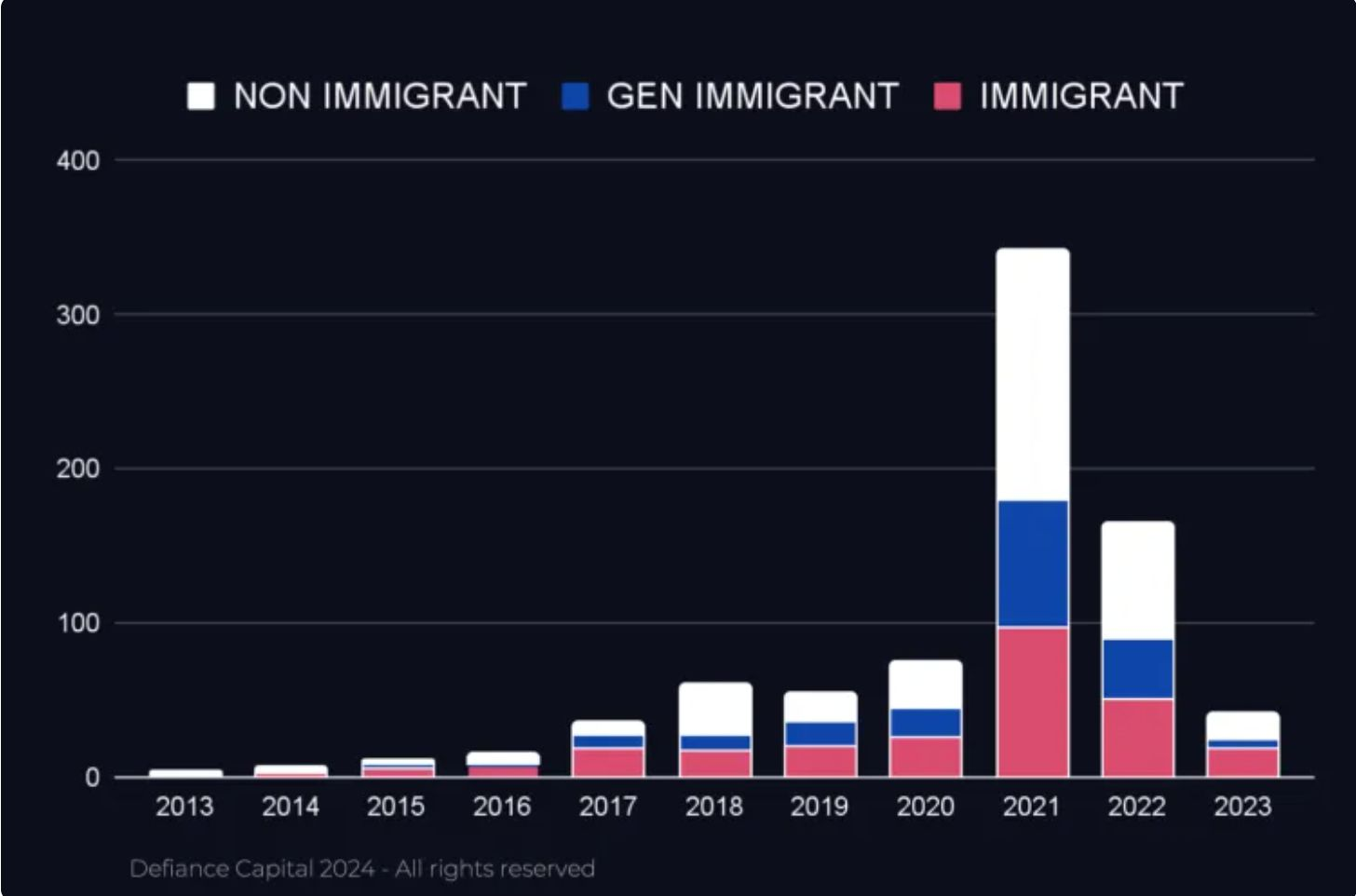
The network effects amplify these advantages exponentially. Startup Genome' s research demonstrates that founders with high Global Connectedness scores - those with five or more connections to top-tier ecosystems - achieve 3.25x higher scaling probability. It's not just who you know; it's how founder relationships compound over time, creating what venture capitalist Fabrice Grinda calls "an unshakeable belief in themselves" that enables persistence where rational actors would retreat.
The traditional management playbook reads like a prescription for startup suicide. Consider the predictable failure patterns: innovation suffocation (67% of founders report this after transitioning to professional management), premature process implementation (54%), cultural misalignment (71%), and timing mismatches (49%). These aren't random failures; they're systematic dysfunctions arising from fundamental incompatibilities between corporate management and entrepreneurial reality.
Brian Chesky's experience at Airbnb exemplifies this tension. Following conventional wisdom nearly destroyed the company before Chesky embraced what he learned from Steve Jobs: founders must stay involved in the details that matter. As Chesky notes, founders are "biological parents" of their companies, maintaining emotional and intellectual connections that hired executives rarely match. This intimate knowledge enables rapid pivots, bold decisions, and sustained innovation that characterise breakthrough companies.
The founder-manager divide cuts particularly deep along gender lines. Female founders face disproportionate pressure to hire professional management, with 73% reporting investor demands for "experienced executives" compared to 41% for male founders. This disparity contributes to women comprising only 17% of US unicorn founders despite demonstrating equivalent success rates when controlling for funding access and industry selection.

What makes this particularly troubling is how identical behaviours receive different interpretations based on gender. A male founder's hands-on involvement gets labelled "passion"; a female founder's similar engagement becomes "micromanagement." Silicon Valley executives noted after Graham's essay that female entrepreneurs often lack "permission" to operate in founder mode - a double standard that constrains precisely the leadership characteristics that drive exceptional outcomes.
Just as the founder-manager debate reaches fever pitch, technology offers an unexpected resolution. Artificial intelligence and automation increasingly enable what LettsGroup terms "Founder Mode at scale" - maintaining entrepreneurial characteristics whilst achieving operational sophistication that once required armies of middle managers.
The numbers are staggering. LettsGroup's AI VentureFactory reports reducing average costs to seed stage from the industry-standard $2 million to below $100,000; a 95% reduction achieved through systematic process automation and AI-powered decision support. This isn't merely about cost efficiency; it's about democratising entrepreneurship by enabling founders to maintain control through extended runway periods that would traditionally force premature delegation.
The AI VentureFactory exemplifies this new paradigm. Built on 15 years of venture development experience, the platform encompasses seven core stages, 49 discrete steps, and hundreds of sub-steps that transform traditionally tacit founder knowledge into reproducible processes. Rather than replacing founder intuition, it amplifies it - automating routine operations whilst preserving the creative chaos that drives innovation.
Real-world results validate the approach. Five ventures built using the methodology have reached seed stage, including LettsCore (blockchain infrastructure), LettsNews (AI-powered media technology), and LettsArt (digital marketplace systems). These aren't incremental improvements but step-function advances: 2.4x faster development cycles, 60% lower customer acquisition costs, and dramatically improved capital efficiency.
The implications extend far beyond individual ventures. If systematic approaches can consistently double success rates, from traditional 10% to targeted 20%, the aggregate impact on venture returns could transform industry economics. More capital would flow to early-stage ventures, more founders could pursue ambitious visions, and more innovations would reach market.
The founder-manager dichotomy manifests differently across global markets, creating fascinating cultural variations. Silicon Valley's risk-embracing ethos naturally favours founder leadership, whilst European markets' regulatory complexity and cultural risk aversion traditionally support professional management. Asian markets split along regional lines: Singapore and Israel embrace founder models whilst Japan and Korea favour hierarchical structures.
Yet technology-enabled approaches offer particular promise for markets outside traditional innovation hubs. The AI VentureFactory's 90% cost reduction proves especially transformative for emerging economies with limited venture capital. Suddenly, entrepreneurs in São Paulo or Lagos can access venture-building capabilities previously exclusive to Silicon Valley, potentially unleashing global innovation waves.
The key insight: technology enables cultural translation of founder principles across diverse contexts. European entrepreneurs can leverage systematic frameworks to satisfy regulatory requirements whilst maintaining founder control. Asian founders can use platforms to bridge hierarchical expectations with entrepreneurial flexibility. The AI VentureFactory doesn't impose Silicon Valley culture; it adapts founder mode principles to local realities.
This cultural adaptability matters because different markets require different approaches. What works in San Francisco's freewheeling environment needs modification for Berlin's process-oriented culture or Tokyo's consensus-building traditions. Systematic methodologies provide the translation layer, enabling founder characteristics to flourish within varying cultural constraints.
Looking ahead, traditional organisational structures appear increasingly obsolete. Research suggests future billion-dollar companies might operate with 10-20 core employees, leveraging AI for functions previously requiring hundreds of staff. This isn't downsizing, it's a fundamental reimagining of how companies create value.
The implications ripple across entire economies. Educational institutions face existential questions about MBA programmes built around industrial-era management principles. Governments must reconsider regulatory frameworks designed for hierarchical corporations. Venture capitalists need new evaluation criteria that assess founders' ability to leverage technology rather than plans for management succession.
Traditional performance metrics such as efficiency ratios, hierarchical reporting structures and predictable quarterly results prove inadequate for innovation-driven organisations. Emerging scorecards prioritise adaptability, learning velocity, and market responsiveness. These new measures favour founder characteristics over management orthodoxy, technology leverage over human hierarchies, and systematic innovation over process optimisation.
The shift demands new thinking from all ecosystem participants. Investors must recognise that the best founders might never "graduate" to professional management. Accelerators should teach systematic innovation rather than traditional scaling. Policy makers need frameworks supporting flat, automated organisations rather than assuming corporate pyramids.
The founder versus manager debate ultimately represents yesterday's question. Tomorrow belongs to leaders who combine founder orientation with systematic execution, maintaining vision and adaptability whilst leveraging AI and automation for operational excellence. This synthesis transcends traditional categories, creating new possibilities for venture building and scaling.
The evidence overwhelmingly supports sustained founder leadership enhanced by technological capabilities. Platforms like LettsGroup's AI VentureFactory demonstrate how systematic methodologies can preserve entrepreneurial DNA whilst achieving operational sophistication. The most successful ventures won't choose between founder and manager modes; they'll synthesise both through technology.
This evolution requires deliberate choices. Founders must develop new competencies in AI utilisation, systematic thinking, and digital organisation building. Investors must fund leaders who refuse traditional transitions to professional management. Educators must reimagine curricula for technology-augmented entrepreneurship.
As venture building evolves from craft to system, the distinction between founder and manager modes blurs into irrelevance. Technology enables founder vision and passion to scale without sacrificing operational excellence. The entrepreneurs who master this synthesis, leveraging platforms like the AI VentureFactory whilst maintaining their essential DNA, will define the next generation of transformative companies.
The future belongs not to founders or managers, but to technology-augmented leaders who transcend traditional categories. They'll build tomorrow's defining enterprises not by choosing between entrepreneurial chaos and managerial order, but by synthesising both through systematic innovation. In this new paradigm, Founder Mode isn't just preserved. It's amplified, systematised, and unleashed at previously impossible scales.
After years of refining our venture-building process through our Innov@te™ methodology, LettsGroup's AI VentureFactory, powered by Innov@te, is available to external ventures. We already have an impressive track record of success and measurable results we've achieved for startups in our ecosystem.
The AI VentureFactory represents the culmination of our venture-building expertise, refined across 3 versions of our Innov@te venture building process and used by 15 sector defining tech ventures:
Our initial version helped launch and scale groundbreaking ventures, including:
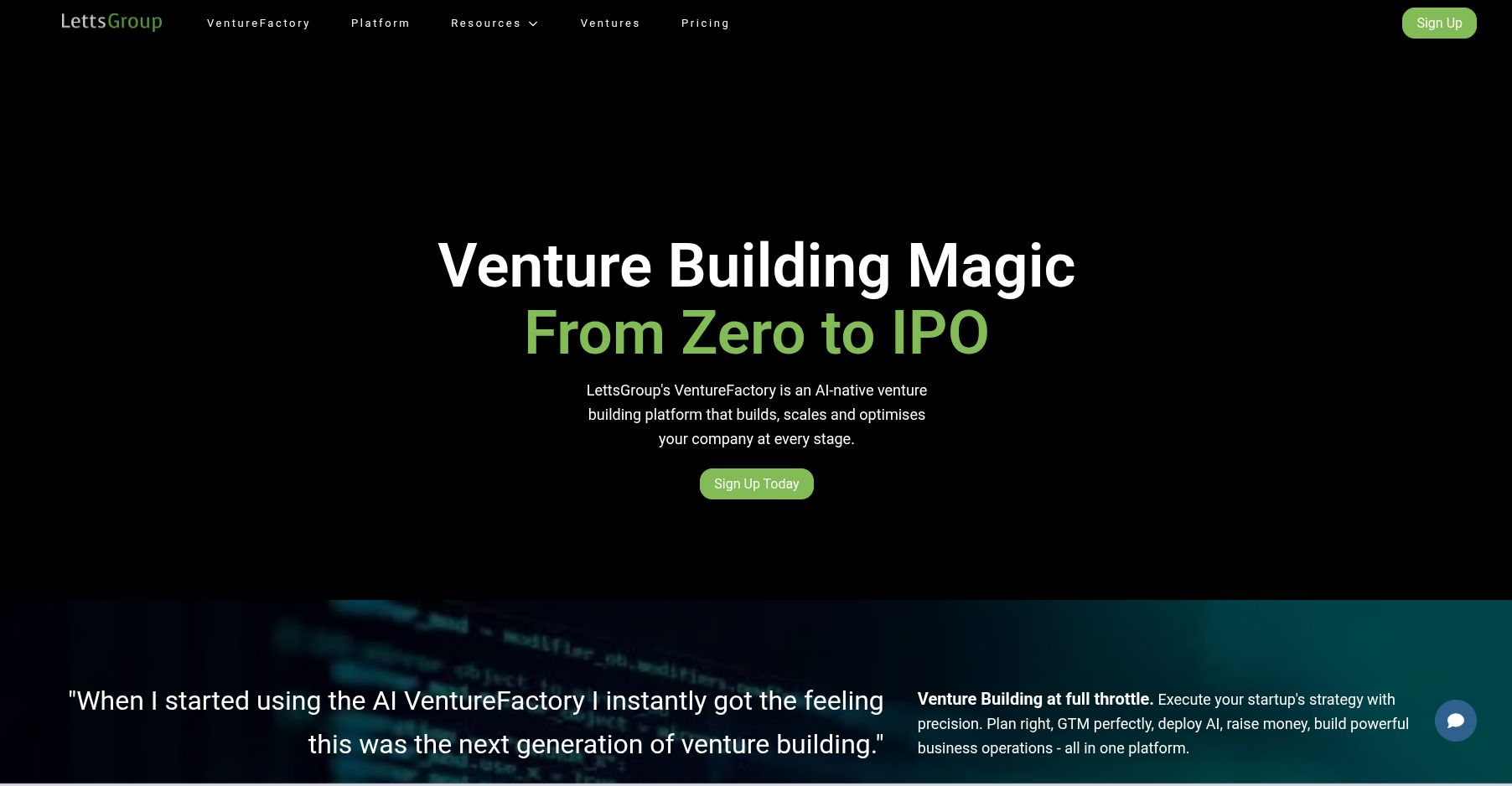
Our second version powered several innovative companies:
Over the last few years we've been developing our next-generation platform, the AI VentureFactory. The results to date have been quite remarkable:
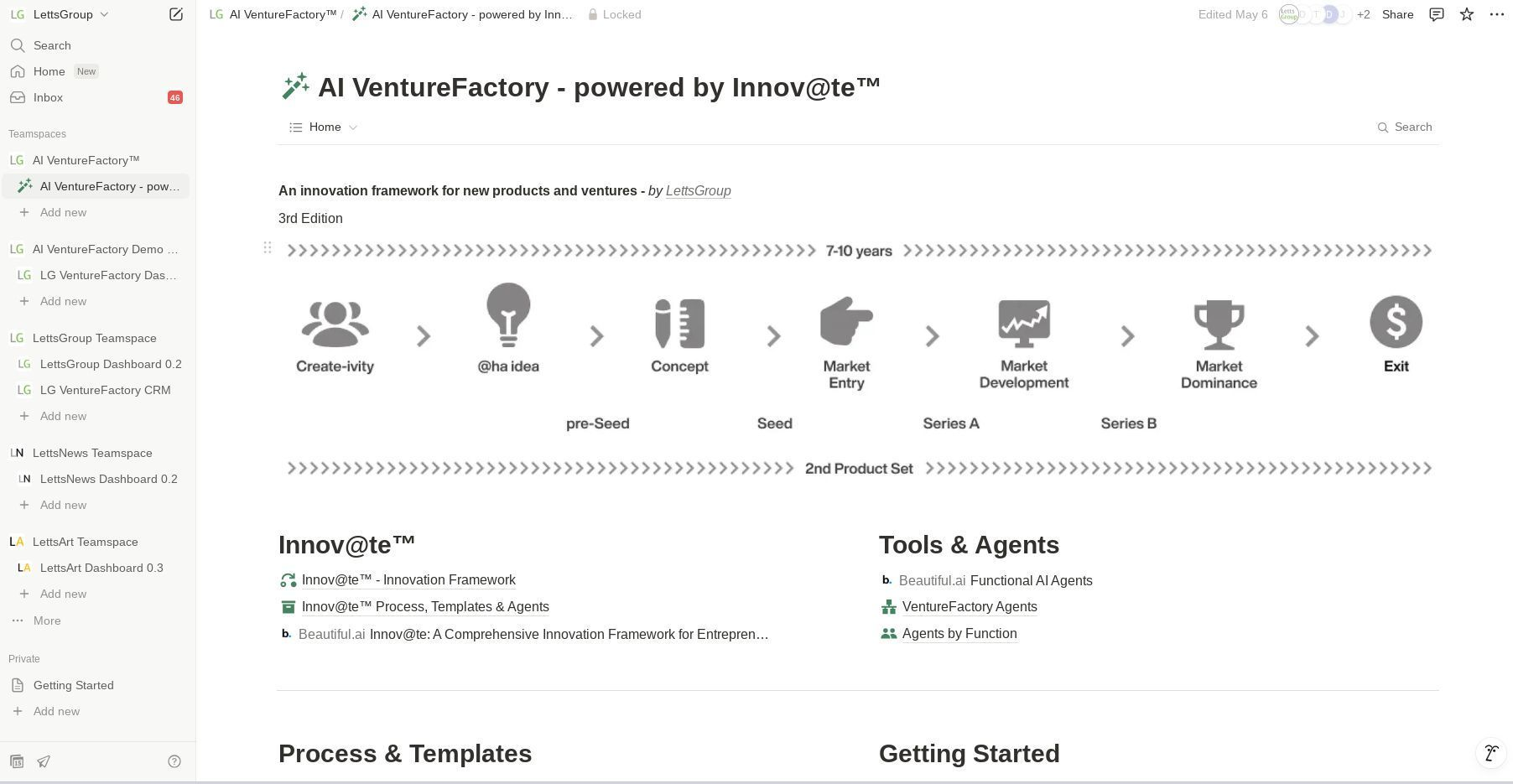
Our AI VentureFactory has demonstrated exceptional performance across several key metrics:

Our five branded ventures showcase the power of our methodology:
A No-Code AI Software Company for the Art World
A Pioneering Nature-Tech Platform
Additional Innovative Ventures
LettsGroup's senior team brings unparalleled expertise to the table:
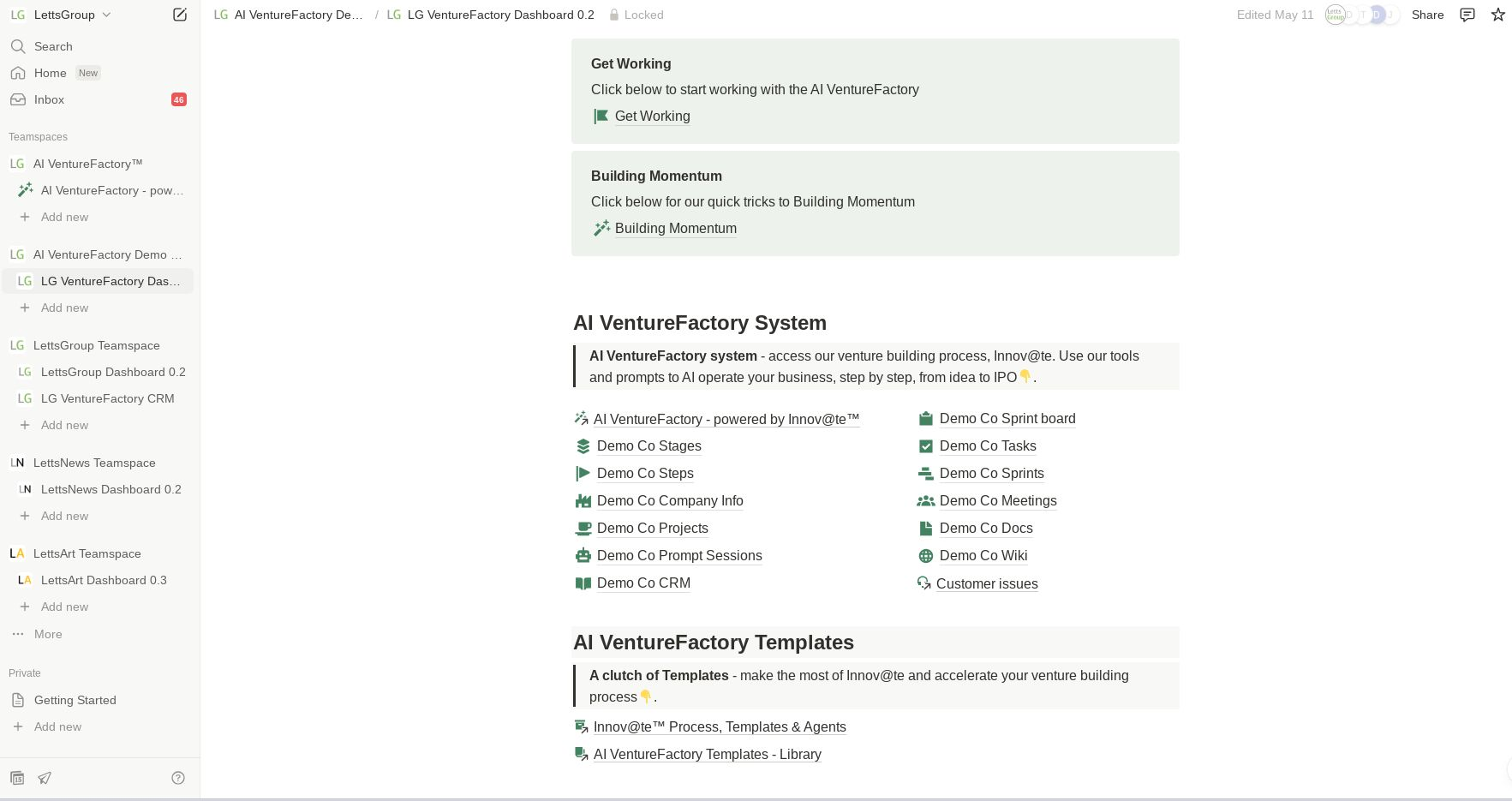
What makes the AI VentureFactory yet more powerful is our comprehensive support system:
We offer a number of additional benefits to our community of entrepeneurs and investors including:
The true value of the AI VentureFactory lies in its ability to navigate the hundreds of key decision points and challenges that tech startups face. Our platform provides the process, structure, tools, automations, and insights to optimise your journey at every stage, ensuring you're never blindsided by "what you don't know you don't know."
With a track record of 15 companies and dozens of tech entrepreneurs successfully using the Innov@te methodology, and a growing number of new startups already scaling with the AI VentureFactory, we're confident you can accelerate your startup's success.
To find out more about the AI VentureFactory platform and our wider programme go to Letts.Group. Alternatively, sign up today at pricing.Letts.Group.
Transform your startup journey with LettsGroup's AI VentureFactory – where innovation meets execution.
The European innovation ecosystem is fundamentally broken. Despite commanding 19% of global R&D investment and housing 43% of the world's premier life sciences universities, Europe has systematically failed to produce technology companies of global significance. This failure is not accidental but structural. It is rooted in a crippling risk aversion that permeates the entire European startup ecosystem. As pre-seed founders, you aren't merely operating within this flawed system; you are actively perpetuating it. Your inability to embrace transformative risk isn't just limiting your company's potential, it's ensuring Europe remains technologically subservient to American innovation for generations to come.#

European startups don't fail because of insufficient technical expertise or inadequate funding ecosystems. They fail because European founders categorically refuse to think beyond incremental improvements and modest market ambitions. It started when Beenz, London’s first fintech sensation and the first global cryptocurrency, moved to New York to scale. When Stripe's Collison brothers needed to build a truly transformative payment infrastructure, they abandoned Europe for Silicon Valley. When Spotify faced the critical scale-up phase, it required American capital and market access to achieve platform status. The pattern is unmistakable and damning.
The market data confirms this systemic deficiency. While American startups routinely target total addressable markets measured in billions, European founders celebrate securing dominance in fragmentary regional markets. Palantir, OpenAI, and SpaceX didn’t emerge from ecosystems that reward cautious, stepwise growth and profit-before-platform - they emerged from systems that demand founders shoot for market transformation or perish trying. Compare this with European "success stories" like Klarna, which spent years building modest payment solutions before finally embracing the high-risk, high-reward buy-now-pay-later model that American competitors had already pioneered.
This pathological timidity manifests in European founders’ obsession with early revenue and premature profitability. Uber sustained billions in losses to establish market dominance; Amazon reinvested profits for over two decades to build an unassailable market position. Meanwhile, European founders proudly showcase "capital efficient" growth models that virtually guarantee they’ll remain subscale relative to American competitors. Monzo and N26 initially celebrated their "responsible growth," only to watch as American fintech companies secured valuations five to ten times higher by aggressively pursuing market share over immediate profitability.
The consequences of this mindset are not theoretical but devastatingly practical. Europe has become the world’s innovation farm team - developing promising technologies only to see them acquired and scaled by American companies when they show signs of genuine breakthrough potential. DeepMind’s acquisition by Google stands as perhaps the most damning example of a world-leading AI research outfit that could have become Europe’s foundational AI champion now serving American strategic interests. This pattern repeats across sectors: Kustomer’s sale to Meta, Skype’s acquisition by Microsoft, and ARM’s sale to SoftBank all represent European innovations ultimately captured and monetised elsewhere.
The Draghi report’s identification of Europe’s "middle technology trap" isn't merely an academic observation. It's an indictment of the founder psychology that pervades the ecosystem. European founders have internalised the region’s regulatory caution and cultural risk aversion, creating companies designed to survive rather than transform. Tesla didn't emerge from a mindset of balanced risk management and incremental market capture; it resulted from Musk's willingness to repeatedly risk bankruptcy to force a transition to electric vehicles. No European automotive startup has shown comparable ambition, despite the continent’s renowned automotive engineering expertise.
This failure of entrepreneurial courage has produced a devastating leadership vacuum. While America has generated multiple generations of visionary founder-leaders from Jobs and Gates to Bezos and Zuckerberg to contemporary figures like Chesky and Altman, Europe has produced precious few comparable figures. This isn’t coincidental but causal. European venture ecosystems systematically select against the psychological profile that produces transformative leaders. Even Stripe’s Patrick Collison has acknowledged that his company could never have achieved its current position had it remained in Europe’s more risk-averse ecosystem.

The path forward requires a fundamental rejection of Europe’s entrepreneurial orthodoxy. Founders must:
Target global market dominance from inception. Revolut distinguished itself precisely by rejecting the regional focus that hamstrung other European fintech startups, immediately building infrastructure for global operations rather than optimising for European regulatory environments.
Embrace extended unprofitability as a strategic weapon. Delivery Hero’s willingness to sustain years of losses to establish market position stands as a rare European example of the approach American startups take for granted.
Design technology platforms with capabilities far beyond current market demands. Adyen’s decision to build payment infrastructure capable of handling transaction volumes 100x their initial market need exemplifies the architectural ambition European startups typically avoid.
Select investors based on risk tolerance rather than operational expertise. Spotify’s decision to partner with American growth investors rather than European venture funds with "sector expertise" proved critical to its survival against Apple Music’s competitive threat.
But even these steps are insufficient unless Europe builds institutions that actively enable and expect this level of ambition from day one. That’s where new models like the AI VentureFactory at LettsGroup point the way forward. Rather than hoping founders will self-correct in a system that punishes risk, the AI VentureFactory is engineered to do what traditional incubators and accelerators will not: build ventures around transformative potential, not incremental feasibility. It systematically removes friction, compresses time to scale, and injects AI-powered ambition into the DNA of every startup it helps create.
The AI VentureFactory doesn’t simply support bold founders - it manufactures them. It challenges conventional European startup thinking by designing ventures for global scale from day one, deploying AI not just as a tool but as a co-founder, and focusing capital and talent on ventures that reimagine entire industries, not just marginally improve them.
The European innovation ecosystem isn’t failing despite its caution - it’s failing because of it. The region’s risk aversion doesn’t protect founders from failure; it guarantees they’ll never achieve transformative success. The existential question for European founders isn’t whether you can create modestly successful companies - the ecosystem already proves this possible. The question is whether you possess the courage and risk-taking conviction to build companies capable of defining technological paradigms rather than merely participating in them.
As Benchmark Capital’s Bill Gurley observed during his European investment tour, “European founders ask how to minimise downside risk; American founders ask how to maximise upside potential.” Until this fundamental psychology shifts - and until new structures like the AI VentureFactory become the norm, not the exception Europe will remain a technological colony: developing innovations for exploitation by American platforms rather than building platforms of its own.
The uncomfortable truth is that Europe doesn’t lack capital, talent, or technical capability. It lacks founders with the audacity to deploy these resources with the singular focus on transformative outcomes that characterise America’s most successful technology companies. This isn’t merely a difference in approach - it represents an existential threat to Europe’s technological sovereignty and economic future. The most patriotic act a European founder can undertake isn’t building a "sustainable" business that creates modest employment - it’s building companies of such ambition and scale that they reshape global markets in Europe’s image.
And if that’s your mission, you don’t need another accelerator - you need a factory for ambition. You need a launchpad built for paradigm shifts. You need to think bigger, risk more, and build what the world doesn't yet know it needs. The next global platform doesn’t have to come from Silicon Valley. It could come from here. But only if you start building like it.
Early stage tech-focused founders can sign up to LettsGroup's AI VentureFactory today. Go to www.Letts.Group.
Today, we sit down to discuss a critical question for the future of European innovation: can Europe do what's necessary to create genuine, successful tech leaders and achieve digital sovereignty? Europe faces a paradox of strong research but lagging high-tech productivity , caught in a "middle technology trap" and hindered by a significant cultural risk aversion that impacts entrepreneurship, investment, and acceptance of failure. How is LettsGroup's AI VentureFactory providing the solution? See more in their recent analysis.

LettsGroup HQ
In April, LettsGroup expanded the VentureFactory's AI capabilities within its Step-by-Step venture building process, while optimising the new Dashboard specifically for pre-Seed tech and digital startups. The platform now boasts an impressive 3rd Party AI Agent library with a new cutting-edge suite of Design Agents complementing its other function-specific agents, alongside new startup CRM capabilities integrated seamlessly into the stack with project, product and collaboration tools. AI VentureFactory benchmarking stats are highlighting compelling advantages for users leveraging this revolutionary venture building-as-a-platform approach. Listen to the teams podcast on the game-changing impact the AI VentureFactory is having on the startup ecosystem in our latest podcast. Last, LettsGroup has been engaging with prominent tech and startup leaders about joining the group as it expands, developed insightful research comparing European and US startup performance, and is hosting an exclusive Demo Day showcasing its deeper tech ventures on May 8th.

LettsCore
LettsCore's team achieved a breakthrough in April by optimising their content management blockchain through a strategic transfer from onchain to offchain content storage - unlocking strong economics as the solution scales in the market. This architectural evolution maintains seamless transparency with the LettsCore API, highlighting the interface's sophisticated effectiveness between applications and content implementation. The team has revolutionised search capabilities by deploying powerful full-text and AI-driven search functionality (successfully tested with OpenAI's ChatGPT 4.0), alongside an innovative Model Control Protocol (MCP) server designed for advanced AI clients like Claude. MCP represents the frontier of AI tool integration, dramatically expanding interaction with LettsCore content across multiple platforms. The team will further expand content distribution by implementing a Mastodon social network server, enabling users to effortlessly auto-promote content through federated social media. This strategic implementation will be able to connect content across multiple other social networks including BlueSky and Threads, positioning LettsCore at the forefront of decentralised content management and sharing.
LettsNews
LettsNews has supercharged its AI-powered 'newsroom tech for everyone' with a number of exciting enhancements. The platform now features sophisticated Advanced Search + AI capabilities, dramatically improving search efficiency through intelligent filters and automated content discovery. The standout addition - an AI-powered Title and Description generator - has garnered enthusiastic user response by functioning as a personalised newsroom editor with customisable tone-of-voice options. The highly anticipated 'Promote' feature is about to launch, set to revolutionise content distribution with frictionless automation to BlueSky initially, with intelligent linking to distributed stories. In an ambitious roadmap, LettsNews is aggressively expanding its AI features and tools to include sophisticated automated content generation for image-specific titles and descriptions, alongside AI-generated Notes and Story drafts - positioning the platform to redefine how digital news is created, optimised, and distributed.
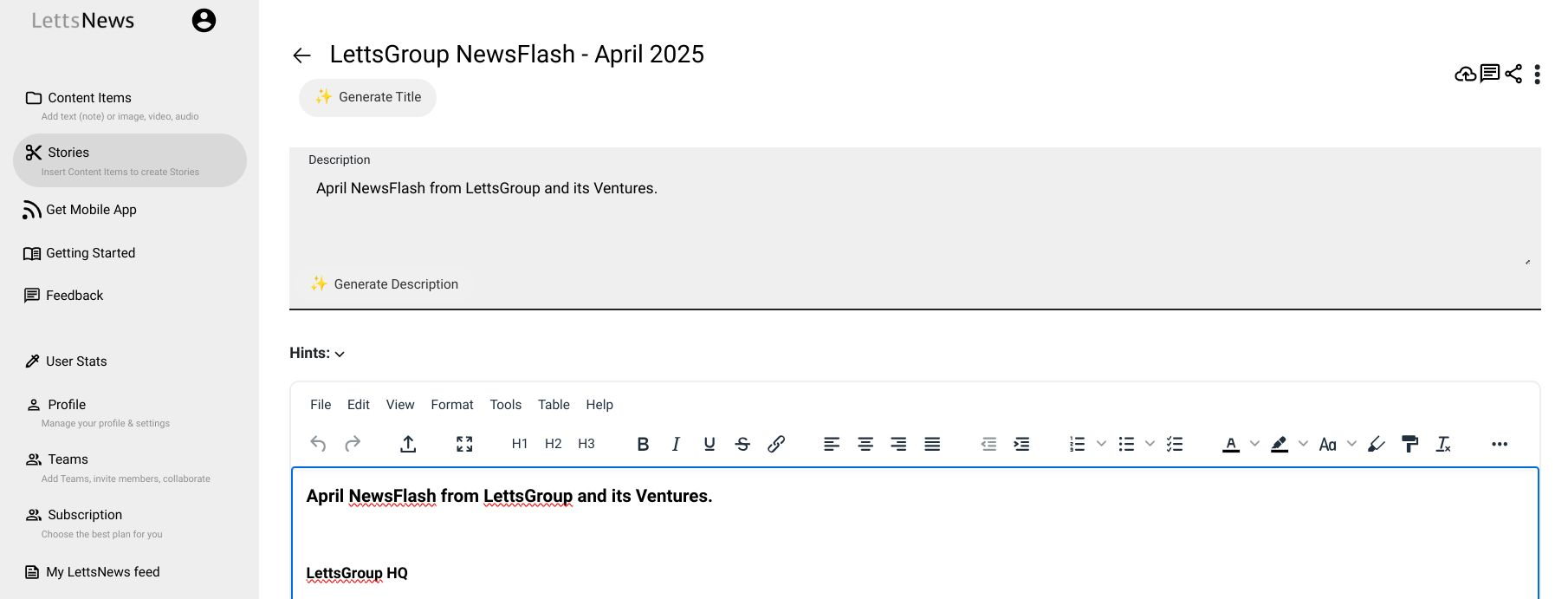
LettsArt
LettsArt is close to reaching 1,000 art galleries using its platform to better manage, distribute and sell art online - which is a major milestone. Its AI, no-code capabilities is initially attracting a wide array of artist galleries showing thousands of artworks with over 3,000 users on its platform. The art-tech startup supports the industry's various fragmented constituents with a new model, semi-private platform that makes buying, selling and managing art and art businesses safe, simple and fast - while flowing more revenues back to the creators. It is building considerable momentum in its early adopter segment of emerging artists while beginning to make inroads into professional studios and with collectors. LettsArt plans to add auto-distribution to leading art marketplaces in the coming months as well as auto-promotion to leading social networks and an exciting clutch of new AI capabilities.
LettsSafari
LettsSafari has seen a strong increase in numbers over the last 90 days, now with approaching 650 subscribers that demonstrate above norm engagement rates - and with wider visitor numbers expanding. The digital platform for mass market rewilding has a focused and loyal base to grow from - with a high percentage of nature restoration leaders and influencers at its core. AI effectiveness within the nature-tech startup is growing behind the scenes. LettsSafari has adopted LettsNews' platform in the field and in-office to optimise the digital platform's content operations and news distribution. LettsSafari is excited about its journey as a digital-first operator with a growing brand in such a physical, lower-tech universe.
Other LettsGroup Ventures
We highlight just a few of our ventures in each monthly edition of The LettsGroup NewsFlash. To explore other LettsGroup ventures go to LettsGroup/ventures.
It's Easter, so here's one that's a little more light-hearted! The giant green egg-planet (below) isn't just LettsSafari's artistic whimsy - it's a perfect symbol for Easter's surprising connections to our planet's biodiversity! And no, we're not just yolking around. Ouch... While most people associate Easter with chocolate bunnies and pastel decorations, environmentally-minded celebrants are hatching a revolution that would make Mother Earth proud. You could call it "Operation Resurrection" for our ecosystems.

Did you know that the European hare - often confused with the "Easter bunny" - is actually a keystone species in rewilding projects across Europe? These "Easter hares" aren't delivering candy; they're delivering ecosystem services through their natural grazing patterns that maintain grassland habitats. Talk about multitasking! They're basically the unpaid landscapers of the natural world. No wonder they need a holiday.
"The irony isn't lost on us," says conservation biologist Dr. Emma Thorne. "The very animal we've turned into a chocolate novelty is critical for restoring biodiversity in certain European landscapes. It's like discovering Santa Claus is actually essential for arctic ice formation."

Easter's spring timing coincidentally aligns with critical breeding periods for countless species. This has inspired a movement of "quiet zone" Easter celebrations, where communities and church groups time their festivities to minimise disruption to wildlife. Because nothing says "Happy Easter" like respecting a woodcock's mating dance! If you've ever seen a woodcock's dance moves, you'd understand they need all the privacy they can get - those birds have rhythm that would make the Easter Bunny hop with envy.
The traditional Easter egg hunt is getting an eco-makeover through "seed eggs" - biodegradable egg-shaped containers filled with native wildflower seeds. Plant these little miracles and watch as they transform into micro-habitats for pollinators. Finally, an Easter egg that gives you something better than a sugar crash and chocolate-stained fingers!
"We've distributed over 50,000 seed eggs across urban areas," reports community organiser Wei Chen. "Children love watching their Easter eggs grow into wildflower patches that attract bees and butterflies. It's Easter magic that lasts well beyond Sunday brunch! And unlike chocolate eggs, these don't mysteriously disappear when parents get late-night munchies."

In the UK, conservation organisations have brilliantly repurposed Easter as an educational platform about ground-nesting birds whose populations have plummeted due to habitat loss. "Wild egg hunts" teach participants to identify and protect bird nests while connecting ancient fertility symbols to modern conservation needs. It's the only Easter egg hunt where finding nothing is actually a win for conservation.
So this Easter, as you admire that chocolate globe or colourful egg, remember you're holding more than a treat - you're holding a symbol of Earth's remarkable biodiversity and our opportunity to help it thrive. Now that's something worth celebrating.
And if anyone asks why you're planting your Easter eggs instead of eating them, just tell them you're expecting a different kind of miracle this year - the kind that doesn't require explaining to your dentist!
Become a member of LettsSafari this Easter and build rewilding safari parks and gardens with us. Some might even house Easter bunnies! Subscribe at LettsSafari.com.
The European Union finds itself in a paradoxical position. The region accounts for 19% of global R&D investment, produces 20% of global scientific publications, and houses 43% of the world's leading life sciences universities. Yet as an ING analysis reveals, from 2000-2019, productivity growth in Europe's high-tech sectors lagged significantly behind the US, with a negative gap of approximately 0.1 percentage points annually in manufacturing of computers and electronics.
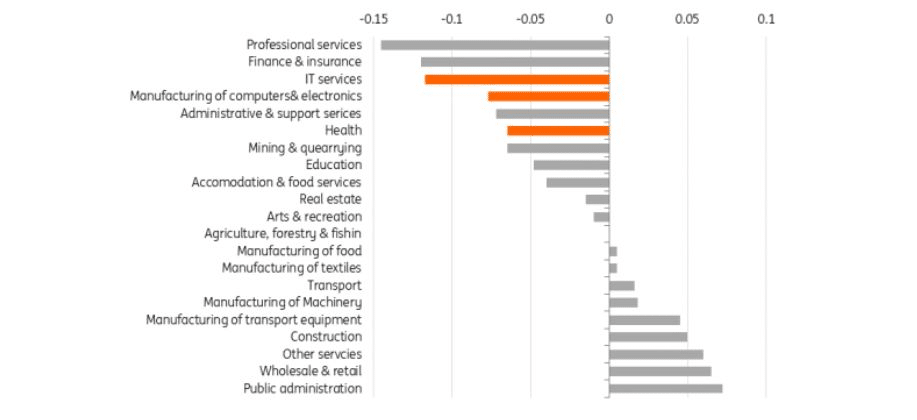
This productivity chasm has profound consequences. While high-tech manufacturing has increased production by an impressive 60% over the past decade, competing sectors in the US have grown faster, widening the transatlantic technology gap. The stark reality, as detailed in the Draghi report, is that Europe's most innovative sectors remain caught in what economists term a "middle technology trap", excelling at incremental improvements while failing to pioneer breakthrough innovations that create market-defining platforms.
"The road ahead is not without challenges," notes Lukas Leitner, a deep tech investor at Lakestar. "The U.S. has a 'flywheel effect' in deep tech while Europe's ecosystem is still immature."
At the heart of Europe's tech leadership deficit lies a profound cultural distinction: risk aversion. As Bloomberg columnist Allison Schrager observes in a recent Japan Times piece, "European culture is just more risk-averse than America's. There is a reason stock ownership is lower and welfare states are bigger in Europe."
This risk aversion manifests in multiple dimensions:
This cultural orientation toward security over opportunity creates a systemic handicap for European tech development. As Leitner observes, "Europe has strong research institutions, engineering talent, and supportive public sentiment for deep tech, but there need to be policy changes to foster a culture that supports taking risks."
Perhaps most critically, Europe suffers from a pronounced leadership gap in its tech ecosystem. While the US has produced daring tech leaders like Elon Musk, Jeff Bezos, and Mark Zuckerberg - figures willing to pursue massively ambitious, high-risk ventures - Europe has generated comparatively few equivalent entrepreneurial icons.

This leadership deficit has several dimensions:
The leadership gap creates a vicious cycle. Without visible examples of audacious tech leaders achieving massive success, the next generation of European entrepreneurs calibrates their ambitions and risk appetites accordingly, perpetuating the pattern of more modest ventures.
Europe's venture capital landscape, while growing, remains fundamentally different from its American counterpart. According to data cited in the ING report, venture capital as a percentage of GDP in the EU is approximately one-fifth of US levels. More troubling, the concentration of late-stage funding is even more pronounced, with European tech companies raising on average just half the capital of their American counterparts at equivalent funding stages.
The funding gap results in a systematic disadvantage for European startups. A recent TechCrunch piece reveals that 50% of the growth capital raised by European deep tech startups comes from outside the continent. The finance issue isn't merely quantitative - it's structural. The EU has been bluntly criticised for a financial infrastructure that is not in place, a struggling market for investing in tech; all ultimately increasing its risk aversion compared to the US.
Europe faces an alarming talent deficit. A Euractiv Advocacy Lab piece documents that against EU targets of 20 million ICT specialists by 2030, current projections suggest only 12 million skilled professionals may be available. This 8-million-person gap represents perhaps the single largest constraint on Europe's digital ambitions.
While Europe has increased its AI professional base tenfold over the past decade, China leads in sheer numbers of AI practitioners. The World Economic Forum forecasts that 70% of the next decade's economic value will stem from digitalisation, making this skills shortage potentially devastating to Europe's competitive position.
Despite decades of integration efforts, Europe's digital landscape remains fragmented. As the ING analysis states, "Cross-border consolidation for economies of scale has proven more difficult in Europe due to fragmented and stricter regulation and competition policies for consumer protection."
This fragmentation creates profound scaling disadvantages. European tech companies must navigate 27 different regulatory regimes, language markets, and consumer preferences - diluting resources and complicating growth strategies. By contrast, American tech companies can achieve massive scale in a single, homogeneous market before approaching international expansion.
Perhaps most alarmingly, Europe has developed critical dependencies on foreign technologies in infrastructure domains. In a 'The Rest is Politics' question time podcast, Campbell and Stewart identify cloud computing as "entirely American" and notes Europe's reliance on US companies for defence resources marked by US-owned data gathering mechanisms.
These dependencies extend into security domains, with specific mention of companies like "SpaceX and Palantir" representing areas where Europe lacks sovereign alternatives. The podcast suggests that the EU is completely reliant on US tech.
Against this challenging backdrop, deep tech may represent Europe's most promising path toward technological sovereignty. According to a 184-page report by venture firms Lakestar, Walden Catalyst, Dealroom, and Hello Tomorrow, deep tech attracted €15 billion ($16.3 billion) in venture investments in Europe in 2024, with nearly one-third of all European venture capital now directed toward deep tech companies.
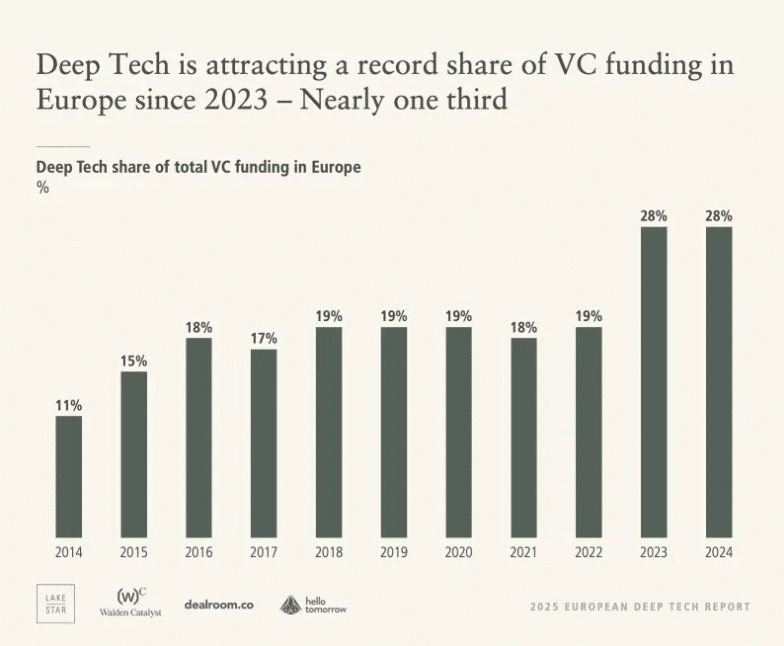
European strengths in deep tech are substantial:
As Arnaud de la Tour, CEO of Hello Tomorrow, notes: "The National Science Foundation, which is the biggest supporter of founder-applied research in the U.S. has had its budget cut by half. A lot of those great scientists don't have a job anymore, and many could come to Europe."
Alongside the deep tech opportunity, innovative approaches to venture creation deserve careful examination. LettsGroup's AI VentureFactory represents one of the most systematic attempts to address Europe's venture-building challenges. The company's approach is based on a fundamental insight: the traditional venture-building process remains remarkably artisanal despite technology transforming nearly every other industry.
LettsGroup has developed what it calls the Innov@te methodology - a comprehensive venture-building framework with seven stages, 49 distinct steps, and hundreds of sub-steps developed over 15 years. This approach transforms what has historically been tacit, founder-dependent knowledge into explicit, transferable systems, potentially offering a solution Europe's crippling risk-averse landscape.
The potential impact is significant. LettsGroup claims its systematic approach can double conventional venture success rates from one successful venture in ten to one in five. If accurate, this would represent a dramatic improvement in capital efficiency - a critical advantage in Europe's more constrained funding environment. The AI VentureFactory also claims it's approach can reduce the cost of venture building by up to 90%.
The AI VentureFactory addresses several European structural challenges:
What makes this approach particularly relevant to Europe's challenges is its systematic nature. Rather than attempting to copy Silicon Valley's high-risk, founder-genius model, LettsGroup has created a structured methodology and AI-powered software platform that potentially fits better with Europe's more process-oriented business culture while still delivering improved outcomes.
For Europe to create genuine tech leaders capable of ensuring digital sovereignty, four essential transformations must occur:
Europe must undertake the difficult but necessary cultural shift toward embracing calculated risk-taking in technology ventures. This doesn't mean abandoning European values of stability and security, but rather recognising, as Schrager puts it, that "technology-driven growth is inherently unpredictable and creates winners and losers."
This shift requires several elements:
The LettsGroup model potentially offers a bridge by creating more systematic approaches to risk management without reducing the inherently risky nature of technological innovation.
The evidence is clear: Europe's capital markets must undergo fundamental transformation. As the ING report states, "European capital markets, fragmented and risk-averse, fail to provide the financing needed for global competitiveness."
This transformation would require regulatory changes to facilitate cross-border investment, institutional shifts in risk appetite, and dedicated mechanisms to bridge the "valley of death" between early-stage funding and growth capital.
Addressing the 8-million-person ICT skills gap requires a comprehensive strategy across education, immigration, and remote work policies. The Euractiv piece highlights one small-scale initiative - Huawei's partnership with UNESCO on ICT competitions - but systemic solutions demand coordinated action at the European level.
Universities must expand technical programs, mid-career retraining initiatives need significant scaling, and Europe must develop compelling value propositions to retain and attract global tech talent.
Europe cannot achieve technological sovereignty across all domains simultaneously.
Such focus might concentrate on deep tech areas where Europe has natural advantages, like photonics computing, which offers "major advantages in speed and efficiency" according to Leitner. By leveraging specific domains of excellence, Europe could develop distinctive technological capabilities that provide strategic independence.

Can Europe create genuine tech leaders capable of ensuring digital sovereignty? The evidence suggests qualified optimism, but only if Europe embraces transformative approaches rather than incremental adjustments.
The deep tech sector's growth, now attracting nearly a third of all European venture capital, indicates investors recognise this potential path to technological sovereignty. Meanwhile, the AI VentureFactory approach developed by LettsGroup offers a systematic methodology that could help Europe maximise returns from its more limited capital resources while addressing the risk aversion challenge.
The current geopolitical environment may also create unexpected opportunities. As de la Tour notes, science defunding in the US could drive talent toward Europe, while photonics computing represents a domain where Europe can lead rather than follow.
As Schrager concludes in her analysis of European risk aversion, "finding the right balance between reducing risk and encouraging growth is as much about values as about economics." Europe possesses the fundamental assets needed for tech leadership: world-class research, substantial financial resources, regulatory sophistication, and democratic legitimacy. What it has historically lacked is the cultural comfort with risk, the leadership examples, and the institutional coordination necessary to translate these assets into global tech leadership positions.
By combining deep tech investment with systematic venture-building methodologies like LettsGroup's AI VentureFactory, while simultaneously undertaking the harder cultural shift toward embracing smart risk-taking and developing more risk-tolerant leaders, Europe might just find its path to genuine technological sovereignty. The stakes couldn't be higher, particularly in the "Trumpocene" era where, as William Burns argues, "Europe urgently needs to rethink technological sovereignty."